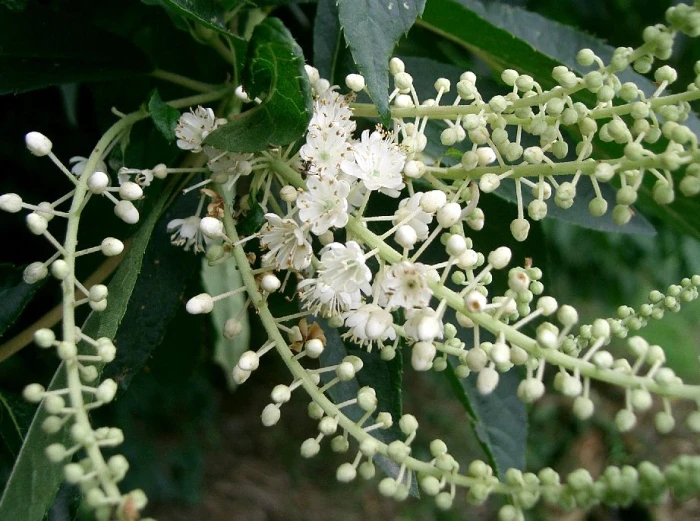Japanese Clethra
(Clethra barbinervis)
Japanese Clethra (Clethra barbinervis)
/
/

KENPEI
CC BY-SA 3.0
Image By:
KENPEI
Recorded By:
Copyright:
CC BY-SA 3.0
Copyright Notice:
Photo by: KENPEI | License Type: CC BY-SA 3.0 | License URL: http://creativecommons.org/licenses/by-sa/3.0/ | Uploader: KENPEI | Publisher: Wikimedia Commons | Title: Clethra_barbinervis2.jpg | Notes: pattypan 22.03 |




























Estimated Native Range
Climate Requirements for Ardmore, Oklahoma
| This Plant | Your Site | Plant Suitability for Your Location | ||
|---|---|---|---|---|
| • Precipitation | 30" - 140" | 38" | Aquatic | Aquatic |
| • High Temp. | 64°F - 92°F | 94°F | Your summers may be too hot for this plant. | Too hot |
| • Low Temp. | 1°F - 44°F | 29°F | Your winter temperatures are normal for this plant | Excellent |
This plant should grow well at your location with about N inches per year (Y minutes per month) of irrigation.
Summary
Clethra barbinervis, commonly known as Japanese Clethra, is a deciduous shrub native to the cool temperate forests of East Asia, including Japan, Korea, and parts of China. It typically grows to about 3 meters (9.8 feet) in height. Japanese Clethra has a distinctive appearance with its dark green leaves that are roughly 5 cm (2 inches) long, and its exfoliating bark that reveals a striking, blackish-brown inner bark on mature specimens. From late summer to autumn, it produces racemes of small, fragrant, white flowers that are about 15 cm (6 inches) long, attracting pollinators and adding ornamental value to the garden.
Japanese Clethra is valued for its fragrant flowers, attractive peeling bark, and the ability to thrive in a range of conditions, including cooler climates. It has earned the Royal Horticultural Society’s Award of Garden Merit, indicating its excellence for garden use. Commonly used in woodland gardens, as a specimen plant, or in borders, it provides multi-season interest. While it prefers full sun to part shade, Japanese Clethra is adaptable to various light conditions and can handle medium to high water requirements. It is best suited to soils with slow to medium drainage. Gardeners should provide a sheltered location to protect it from harsh winds in colder regions.CC BY-SA 4.0
Japanese Clethra is valued for its fragrant flowers, attractive peeling bark, and the ability to thrive in a range of conditions, including cooler climates. It has earned the Royal Horticultural Society’s Award of Garden Merit, indicating its excellence for garden use. Commonly used in woodland gardens, as a specimen plant, or in borders, it provides multi-season interest. While it prefers full sun to part shade, Japanese Clethra is adaptable to various light conditions and can handle medium to high water requirements. It is best suited to soils with slow to medium drainage. Gardeners should provide a sheltered location to protect it from harsh winds in colder regions.CC BY-SA 4.0
Plant Description
- Plant Type: Shrub
- Height: 10-20 feet
- Width: 10-15 feet
- Growth Rate: Moderate
- Flower Color: White
- Flowering Season: Summer
- Leaf Retention: Deciduous
Growth Requirements
- Sun: Full Sun, Part Shade
- Water: Medium, High
- Drainage: Slow, Medium
Common Uses
Bee Garden, Bird Garden, Butterfly Garden, Deer Resistant, Edible*Disclaimer: Easyscape's listed plant edibility is for informational use. Always verify the safety and proper identification of any plant before consumption., Fragrant, Hummingbird Garden, Rabbit Resistant, Salt Tolerant, Showy Flowers
Natural Habitat
Cool temperate forests of East Asia
Other Names
Common Names: 매화오리나무
Scientific Names: Clethra barbinervis, Clethra wuyishanica, Clethra barbinervis var. kawadana, Clethra japonica, Clethra japonica publ, Clethra kawadana, Clethra stolonifera, Clethra wuyishanica var. erosa
GBIF Accepted Name: Clethra barbinervis Siebold & Zucc.